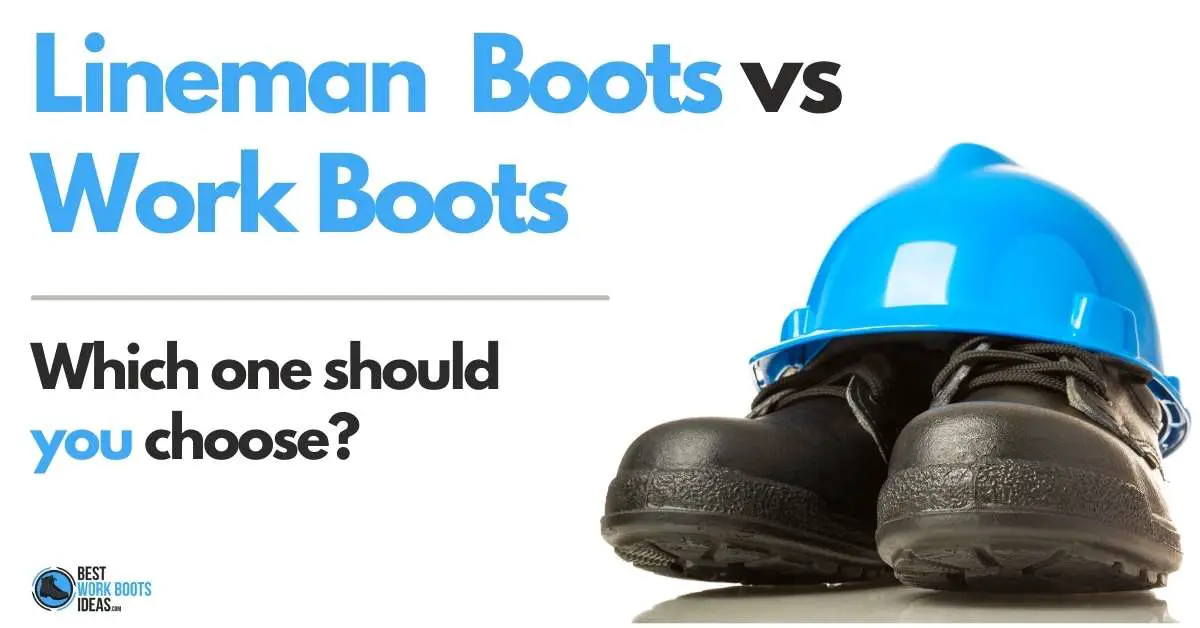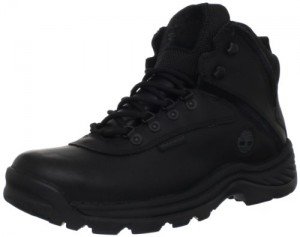Lineman boots vs Logger boots: Learn all you need to know about which footwear you should choose

It’s good to know a variety of boot types so you’re able to find a pair that best matches your needs.
For that reason I’m going to cover the characteristics and differences between lineman and logger boots.
Each of these styles provide a special set of features for the type of work being completed.
Sometimes they overlap, at others they don’t.
After this article you’ll know the differences and be able to shop for these styles with confidence.
Contents
Top 3 Features of Lineman Boots
Lineman boots, or ‘climbers’, are designed to protect workers such as yourself from dangers that come with your work.
If you regularly scale telephone poles or trees then they’re definitely made for you.
Below are three common features that define a lineman boot.
Thick Uppers, Gaff Ready Outsoles
Lineman boots are built with hearty uppers and outsoles to withstand the brutal work of climbing.
Climbing gaffs (gaffs) are expected to be attached to the boot and calf of the worker.
A Gaff is a device with a spike that can be dug in the trunk of wood, supporting the person wearing them.
Using gaffs to scale any wood object is something that requires extensive training and is not to be done by someone inexperienced.
Because of the amount of stress being put on them by the gaffs and users’ body weight, linemen’s boots are designed and built to be particularly durable.
Strong materials, strong construction methods, and even some features found almost nowhere but in climbers.
The thickness of climbers’ uppers is usually at least two millimeters, this creates a very firm structure that helps support your feet and ankles.
Beyond that, it’s not uncommon for linemen’s boots to have an additional millimeter or two of extra leather along the sides of the uppers.
There are even some that have steel reinforced uppers to make absolutely certain that the boots don’t collapse under the weight of an ascending body.
This level of construction may seem like overkill at home, but when you’re dozens of feet in the air climbing a pole, you want to know they’re strong and stable
Supportive Shanks
Another defining feature of climbers is that their shanks are stronger than other boots.
In some instances manufactures even double up on the shank.
This is to support the concentrated and continuous pressure being applied by the gaffs throughout work. If you’re not perfectly clear what a shank is, this Rose Anvil video does a great job of showing what you need to know about shanks.
It would also help to check out the different parts of a work boot if you’re unclear on the purpose of a shank.
In addition to the reinforced shank, the space between the pad and heel of the outsole, the area the shank spans, is set back more than on other boots.
This creates an area for the gaff to comfortably slide into while the worker is climbing
Tall Boots, All Day
Lineman boots are notably taller than most boots with a range of between 10 to 20 inches in height.
This is to add extra stability for the physical stress of climbing, as well as to protect the user from their gaffs digging into the side of their leg.
Think of being on crutches and how quickly your underarms get tired from the uncommon pressure.
The same thing can happen to the sides of your legs from gaffs and for this reason linemen prefer a taller boot.
In addition to all the blunt force that extra tall boot protects against, it lowers the likelihood of getting snagged on something.
There are all sorts of things that will hook your clothing while climbing.
A tree will get you with branches, but telephone poles are the most dangerous. With years of nails, screws, and other fasteners used to affix things to the pole, rubbing up against a pole could cut you pretty badly.
I’ve gotten cut on the staples left over from garage sale flyers, I certainly wouldn’t want to do that with my leg or chest.
Even on a pole without any metal to snag skin, it’s possible to hurt yourself pretty badly with splinters alone!
Obviously linemen climb in a way as to avoid that, but enough time doing line work and eventually a situation will arise where there’s a dangerous maneuver.
It only takes once to absolutely shred your calves with metal or splinters, so it’s best to be prepared for that day.
Top 3 Features of Logger Boots
Logging boots are designed for those working in the lumber industry.
They perform best in wild natural terrain on jobs that require high levels of protective boot features.
Hearty Outsoles and Heels
Loggers’ outsoles are super thick, hearty, and able to grab onto the wildest surfaces out there.
Deep lug pattern allows your foot to grab even in the most irregular terrain.
This allows for unparalleled and excellent traction when you need it most.
Raised heels are one of the characteristics of Loggers.
This is done to give a more even surface for someone that might be walking uphill.
On your next purchase, look out for a Vibram Outsole. Brands like White’s Boots, Danner, Justin, Chippewa, Thorogood and Georgia Boot are just a few.
Gusseted Tongue
Loggers are often designed with a gusseted tongue to keep any flying debris from getting inside the boots throughout the day.
A gusset is simply the material stitched between the tongue and the upper so there is no gap for any materials to sneak in.
In work conditions where sawdust and woodchips are flying around all day, every day, this is a huge feature.
Anyone who’s done tree work or used a chipper, it’s amazing how quickly a woodchip finds its way inside your boot.
You have to wait till a break, then take your boot off, probably get your sock wet in the process.
It’s a nightmare and it’s all solved with a gusseted tongue.
In addition to protection against solid materials, the gusseted tongue also helps protect against any water sneaking in through the tongue.
You may sometimes see boots advertised as half or three-quarter gusset, this just refers to the amount of the tongue that has a gusset attached to it.
You can imagine that for a 16 inch boot, you probably wouldn’t have a full gusset.
Protective uppers
Logger boots are often built with possibly the most advanced safety technology on the market.
With modern aramid fibers and completely airtight membranes, certain loggers are borderline indestructible.
Certain aramid fiber uppers are chainsaw proof.
As a lumberjack, using and being around blades is just part of the job.
As careful as everyone tries to be, accidents happen, and nowhere is that more true than in the lumber industry.
Having these features can be life changing.
Additionally, the vamps and exteriors are often heat and chemical resistant as well.
This makes a difference to lumber workers who are often around hot engines and the potentially harmful chemicals needed to operate them.
All of this is in addition to a protective toe cap.
This makes logger boots among the safest on the market for impact and injury to the foot.
3 Biggest Differences Between Lineman Boots and Loggers.
Type of Protection
While both boots are highly-safety focused, they provide that in different ways.
Loggers can take a beating from falling, crushing, or even cutting objects.
Lineman boots are designed more to handle the physical stress of climbing with gaffs day in and day out.
Height and Weight
Lineman boots are far and away the tallest boot I’ve looked at.
I understand that a 10 inch logger boot might seem like alot, but put it next to a 16 or even 20 inch lineman boot and they’re not even in the same ballpark
Lineman boots also take the cake with the weight.
Given how much taller they are, it makes sense that they would weigh more.
Add on top of that double or triple layer leather exteriors on the boot sides, and potential steel bracing as well, and there’s no competition.
Heel
Lineman and logger boots each have a specific heel design, this is the final way in which they differ.
You might not notice this, but this has a big effect on how they perform.
With lineman boots, the heel is set back as to allow the foot a more comfortable fit into the gaff climbers.
With loggers, the heel itself is raised up to create a more level surface to someone walking up an incline.
While these features wouldn’t be completely incompatible in other situations, they certainly lose the benefit of their intended design.
Are There Similarities Between Lineman and Logger Boots
There are some similarities between Lineman and Logger boots, but they perform different tasks in different ways, so they shouldn’t be seen as interchangeable.
Wearing either one in the wrong situation could at best make for a terrible day at work, and at worst get you hurt.
Both lineman’s boots and loggers are durable boots, there’s no doubt about it.
If it was about durability and the choice was one of these two or a regular pair of work boots, I’d take the loggers and climbers any day of the week
The conditions logging and climbing are both far tougher than the average construction job, so it makes sense that this would be the case.
I just wouldn’t want to use one in the wrong situation.
Imagine, walking a mountain in 18 inch, triple-reinforced upper, double shank lineman boots.
You’d be exhausted and that would be a nightmare.
Conversely, imagine climbing a pole or tree in regular, 11 inch loggers.
Your calf is entirely exposed to any splinters or rusty nails on the pole, your foot aching for want of better support for the climbing gaff.
This also is a complete nightmare.
You should ensure that your boots adhere to at least a ASTM F2413 standard.
That’s What You Need To Know About Lineman Boots vs Logger Boots
I hope this has been helpful for you, and you’re better prepared next time you have to buy a quality boot, or show your knowledge in a boot-related conversation.
Just because a boot has a certain title doesn’t automatically mean it’s going to make your job easier.





![Are Steel Toe Boots Safe [featured image]](https://www.bestworkbootsideas.com/wp-content/uploads/2022/03/are-steel-toe-boots-safe-featured-image-300x157.jpg)
![how to break in steel toe boots [featured image]](https://www.bestworkbootsideas.com/wp-content/uploads/2023/07/how-to-break-in-steel-toe-boots-featured-image-300x157.jpg)